高中英语教学案例分析
- 格式:doc
- 大小:243.00 KB
- 文档页数:10
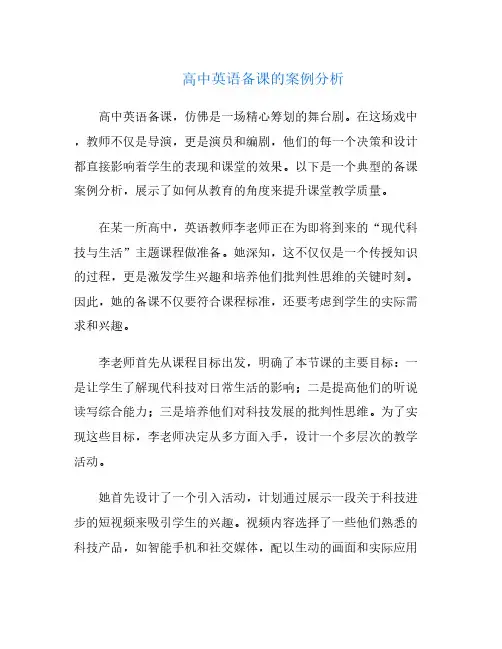
高中英语备课的案例分析高中英语备课,仿佛是一场精心筹划的舞台剧。
在这场戏中,教师不仅是导演,更是演员和编剧,他们的每一个决策和设计都直接影响着学生的表现和课堂的效果。
以下是一个典型的备课案例分析,展示了如何从教育的角度来提升课堂教学质量。
在某一所高中,英语教师李老师正在为即将到来的“现代科技与生活”主题课程做准备。
她深知,这不仅仅是一个传授知识的过程,更是激发学生兴趣和培养他们批判性思维的关键时刻。
因此,她的备课不仅要符合课程标准,还要考虑到学生的实际需求和兴趣。
李老师首先从课程目标出发,明确了本节课的主要目标:一是让学生了解现代科技对日常生活的影响;二是提高他们的听说读写综合能力;三是培养他们对科技发展的批判性思维。
为了实现这些目标,李老师决定从多方面入手,设计一个多层次的教学活动。
她首先设计了一个引入活动,计划通过展示一段关于科技进步的短视频来吸引学生的兴趣。
视频内容选择了一些他们熟悉的科技产品,如智能手机和社交媒体,配以生动的画面和实际应用的案例。
这个活动不仅能够引发学生的好奇心,还能够帮助他们建立起对主题的初步理解。
接着,李老师设计了一组互动活动,以增强学生的参与感。
她安排了小组讨论,要求学生们就科技对生活的影响展开讨论,并准备一个小组报告。
这个环节不仅促进了学生之间的合作,还提高了他们的表达能力和逻辑思维能力。
在讨论过程中,李老师巡回指导,注意听取每个小组的观点,并适时提出问题,引导他们深入思考。
为了进一步巩固学生对科技相关词汇和表达方式的掌握,李老师设计了一系列的词汇和语法练习。
她通过设计填空题、配对练习和造句题等形式,帮助学生们在具体的语境中使用新学的词汇和句型。
这些练习不仅有助于词汇的记忆,也能够提高学生的语言运用能力。
在课堂的最后,李老师安排了一个写作任务,让学生们写一篇关于“科技对生活的影响”的短文。
这个任务不仅考察了学生对主题的理解,也测试了他们的写作能力。
为了确保学生能够充分发挥,她在任务前进行了详细的写作指导,强调了写作结构和逻辑的重要性。
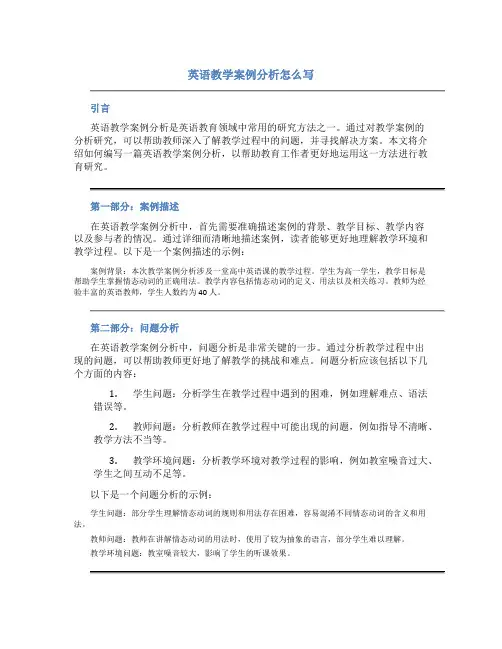
英语教学案例分析怎么写引言英语教学案例分析是英语教育领域中常用的研究方法之一。
通过对教学案例的分析研究,可以帮助教师深入了解教学过程中的问题,并寻找解决方案。
本文将介绍如何编写一篇英语教学案例分析,以帮助教育工作者更好地运用这一方法进行教育研究。
第一部分:案例描述在英语教学案例分析中,首先需要准确描述案例的背景、教学目标、教学内容以及参与者的情况。
通过详细而清晰地描述案例,读者能够更好地理解教学环境和教学过程。
以下是一个案例描述的示例:案例背景:本次教学案例分析涉及一堂高中英语课的教学过程。
学生为高一学生,教学目标是帮助学生掌握情态动词的正确用法。
教学内容包括情态动词的定义、用法以及相关练习。
教师为经验丰富的英语教师,学生人数约为40人。
第二部分:问题分析在英语教学案例分析中,问题分析是非常关键的一步。
通过分析教学过程中出现的问题,可以帮助教师更好地了解教学的挑战和难点。
问题分析应该包括以下几个方面的内容:1.学生问题:分析学生在教学过程中遇到的困难,例如理解难点、语法错误等。
2.教师问题:分析教师在教学过程中可能出现的问题,例如指导不清晰、教学方法不当等。
3.教学环境问题:分析教学环境对教学过程的影响,例如教室噪音过大、学生之间互动不足等。
以下是一个问题分析的示例:学生问题:部分学生理解情态动词的规则和用法存在困难,容易混淆不同情态动词的含义和用法。
教师问题:教师在讲解情态动词的用法时,使用了较为抽象的语言,部分学生难以理解。
教学环境问题:教室噪音较大,影响了学生的听课效果。
第三部分:解决方案在英语教学案例分析中,解决方案是针对问题的具体措施和建议。
通过提出解决方案,可以帮助教师更好地解决教学过程中遇到的问题,并提高教学效果。
以下是一个解决方案的示例:针对学生问题:教师可以采用多种教学方法,例如通过实例讲解、小组合作学习等方式帮助学生理解情态动词的用法。
同时,可以设计一些专门的练习,加强学生对情态动词的掌握程度。
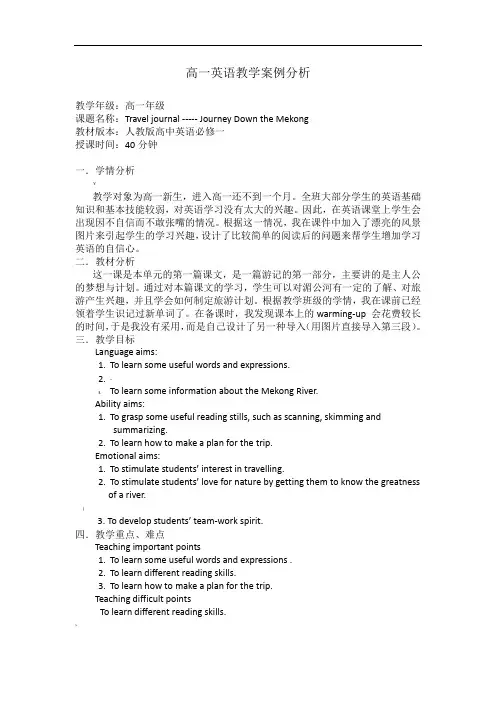
高一英语教学案例分析教学年级:高一年级课题名称:Travel journal ----- Journey Down the Mekong教材版本:人教版高中英语必修一授课时间:40分钟一.学情分析¥教学对象为高一新生,进入高一还不到一个月。
全班大部分学生的英语基础知识和基本技能较弱,对英语学习没有太大的兴趣。
因此,在英语课堂上学生会出现因不自信而不敢张嘴的情况。
根据这一情况,我在课件中加入了漂亮的风景图片来引起学生的学习兴趣,设计了比较简单的阅读后的问题来帮学生增加学习英语的自信心。
二.教材分析这一课是本单元的第一篇课文,是一篇游记的第一部分,主要讲的是主人公的梦想与计划。
通过对本篇课文的学习,学生可以对湄公河有一定的了解、对旅游产生兴趣,并且学会如何制定旅游计划。
根据教学班级的学情,我在课前已经领着学生识记过新单词了。
在备课时,我发现课本上的warming-up 会花费较长的时间,于是我没有采用,而是自己设计了另一种导入(用图片直接导入第三段)。
三.教学目标Language aims:1.To learn some useful words and expressions.2."3.To learn some information about the Mekong River.Ability aims:1.To grasp some useful reading stills, such as scanning, skimming andsummarizing.2.To learn how to make a plan for the trip.Emotional aims:1.To stimulate students’ interest in travelling.2.To stimula te students’ love for nature by ge tting them to know the greatnessof a river.|3. To develop students’ team-work spirit.四.教学重点、难点Teaching important points1.To learn some useful words and expressions .2.To learn different reading skills.3.To learn how to make a plan for the trip.Teaching difficult pointsTo learn different reading skills.~五.教法Task-based methodDiscussionCooperative learning methods六.教学辅助手段Multimedia and other normal teaching tools.七.教学过程设计Step 1. Lead-in"1. Show some beautiful pictures and have students enjoy the beautiful scenery along the Mekong River.2. Questions: 1> Do you like the beautiful scenery2> Where do you think we can see the beautiful sceneryStep 2. Fast reading1.Ask students to read the title of the passage and read the paragraph 3 andfillin the blanks. Then, check the answers and have students enjoy the pictures again. Now, students know that if they travel along the Mekong River, they can enjoy the beautiful scenery.Qinghai (glacier)Yunnan(valleys)rapidsEnters wide valleys (waterfall)Leaves ChinabrownSoutheast Asia(hills,low valleys and plains)delta seaParagraph 3small_________________clear_____cold______________wide____warm_______________________Fast reading2.Teacher: Mekong River is the longest river in Southeast Asia, in China , it’s【called Lancang River and out of China it’s called Mekong River. So, which countries does the Mekong River flow through3.Ask students to look at the map and list the countries that the Mekong River flows through.Step 3. Careful reading1. Ask students to read the paragraph 1-2 and answer the questions:1> Who will travel in the text2> How are they getting there3> Where are they going)4> What did Wang Wei prepare for the trip5> What didn’t she prepare for the trip2. Check the answers.3. According to the questions, they can draw a conclusion: If we want to have a trip, we should think about people, destination, transportation, preparation.Step 4. Discussing and speakingAsk students to discuss with their partners about the characteristics of Wang Weiand Wang Kun.Wang Wei: stubborn; determined; would not change her mind; adventurous:Wang Kun: careful; well-organizedAccording to the discussion, they can draw a conclusion: If we want to have a trip, we need the people with different characteristics.Step 5. SummaryAccording to fives questions and discussion, they can summarize how to make a plan for a trip.Step 6. Homework:Make a plan for the trip. ( the present continuous tense)1. Where are you going to】2. How are you going to...3. When are you leaving4. What are you going to take with you5. Where are you staying6. How long are you staying in…7. When are you coming back八.教学反思这是本单元的第一篇reading,我在设计的时候进行了新的尝试。
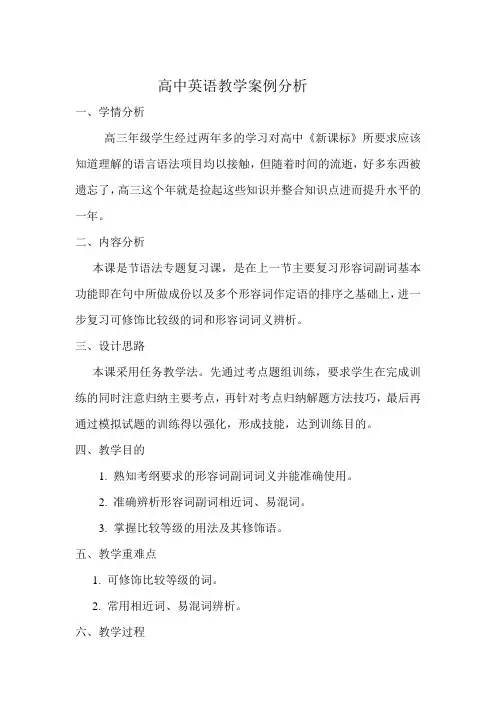
高中英语教学案例分析一、学情分析高三年级学生经过两年多的学习对高中《新课标》所要求应该知道理解的语言语法项目均以接触,但随着时间的流逝,好多东西被遗忘了,高三这个年就是捡起这些知识并整合知识点进而提升水平的一年。
二、内容分析本课是节语法专题复习课,是在上一节主要复习形容词副词基本功能即在句中所做成份以及多个形容词作定语的排序之基础上,进一步复习可修饰比较级的词和形容词词义辨析。
三、设计思路本课采用任务教学法。
先通过考点题组训练,要求学生在完成训练的同时注意归纳主要考点,再针对考点归纳解题方法技巧,最后再通过模拟试题的训练得以强化,形成技能,达到训练目的。
四、教学目的1. 熟知考纲要求的形容词副词词义并能准确使用。
2. 准确辨析形容词副词相近词、易混词。
3. 掌握比较等级的用法及其修饰语。
五、教学重难点1. 可修饰比较等级的词。
2. 常用相近词、易混词辨析。
六、教学过程Task 1. The topic group training (1 )Ask students to finish the topic group 1 in ten minitues .While they are doing , they are asked to pay attention to the testing centres.(教师要求学生在完成训练的同时注意归纳主要考点,为下一步归纳考点做准备。
)Task 2. Induction of the testing centres.Ask students to present all the words that can modify comparative adjectives.Students’ answers:much, far, rather, a lot, a bit, still, even, no, a little, a great deal, by far, any etc.The teacher ask studens to show good ideas of keeping them in mind.( 教师在要求学生想办法把自己所列12 个能够修饰比较级的词记住时,学生犯难了。
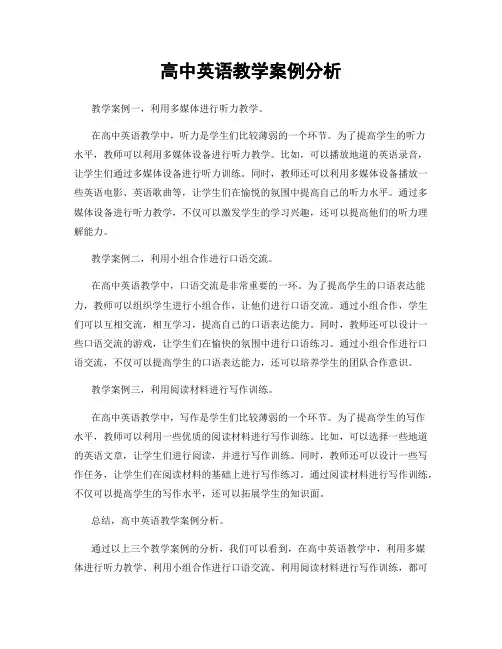
高中英语教学案例分析教学案例一,利用多媒体进行听力教学。
在高中英语教学中,听力是学生们比较薄弱的一个环节。
为了提高学生的听力水平,教师可以利用多媒体设备进行听力教学。
比如,可以播放地道的英语录音,让学生们通过多媒体设备进行听力训练。
同时,教师还可以利用多媒体设备播放一些英语电影、英语歌曲等,让学生们在愉悦的氛围中提高自己的听力水平。
通过多媒体设备进行听力教学,不仅可以激发学生的学习兴趣,还可以提高他们的听力理解能力。
教学案例二,利用小组合作进行口语交流。
在高中英语教学中,口语交流是非常重要的一环。
为了提高学生的口语表达能力,教师可以组织学生进行小组合作,让他们进行口语交流。
通过小组合作,学生们可以互相交流,相互学习,提高自己的口语表达能力。
同时,教师还可以设计一些口语交流的游戏,让学生们在愉快的氛围中进行口语练习。
通过小组合作进行口语交流,不仅可以提高学生的口语表达能力,还可以培养学生的团队合作意识。
教学案例三,利用阅读材料进行写作训练。
在高中英语教学中,写作是学生们比较薄弱的一个环节。
为了提高学生的写作水平,教师可以利用一些优质的阅读材料进行写作训练。
比如,可以选择一些地道的英语文章,让学生们进行阅读,并进行写作训练。
同时,教师还可以设计一些写作任务,让学生们在阅读材料的基础上进行写作练习。
通过阅读材料进行写作训练,不仅可以提高学生的写作水平,还可以拓展学生的知识面。
总结,高中英语教学案例分析。
通过以上三个教学案例的分析,我们可以看到,在高中英语教学中,利用多媒体进行听力教学、利用小组合作进行口语交流、利用阅读材料进行写作训练,都可以有效地提高学生的英语学习水平。
因此,教师们在教学中可以根据学生的实际情况,灵活运用这些教学案例,从而更好地促进学生的英语学习。
希望以上案例可以为广大英语教师提供一些借鉴和启发,让我们共同努力,为学生的英语学习创造更好的教学环境。

高中英语教师教学案例分析范文6篇Teaching English at the high school level requires a deep understanding of the subject matter, effective instructional strategies, and the ability to engage and motivate students. Effective English teachers must possess a range of skills and knowledge to ensure their students develop proficiency in reading, writing, speaking, and listening. This essay presents six case studies that illustrate the diverse teaching practices and approaches employed by successful high school English teachers.Case Study 1: Incorporating Technology to Enhance Engagement Mrs. Emily Johnson, a veteran English teacher at Westside High School, has embraced the use of technology to create dynamic and engaging lessons. She regularly incorporates multimedia elements, such as interactive presentations, educational videos, and online discussions, to supplement her traditional instruction. By leveraging technology, Mrs. Johnson is able to cater to the diverse learning styles of her students and maintain their attention throughout the lesson. Her students have reported feeling more engaged and motivated to participate in class activities, leading to improvedcomprehension and academic performance.Case Study 2: Differentiated Instruction for Diverse LearnersMr. Liam Patel, an English teacher at Eastwood High School, recognizes the importance of addressing the unique needs and abilities of each student in his classroom. He employs a range of differentiated instructional strategies to ensure that all of his students, regardless of their academic level or learning preferences, have the opportunity to succeed. This includes offering tiered assignments, providing scaffolding for struggling learners, and incorporating project-based learning to allow students to demonstrate their understanding in various ways. By tailoring his instruction to the individual needs of his students, Mr. Patel has seen a significant improvement in their overall academic achievement and engagement.Case Study 3: Fostering Critical Thinking through Socratic Seminars Ms. Olivia Hernandez, an English teacher at Northside High School, is a strong proponent of the Socratic seminar approach. She regularly facilitates discussions in which students engage in deep, thoughtful dialogue about complex literary texts, challenging them to analyze, interpret, and defend their ideas. By encouraging students to question, explore, and critically examine the material, Ms. Hernandez helps them develop essential critical thinking and communication skills. Her students have reported feeling more confident in theirability to express their ideas and engage in meaningful intellectual discourse.Case Study 4: Integrating Interdisciplinary ConnectionsMr. Ethan Nguyen, an English teacher at Southside High School, recognizes the importance of helping his students make connections between the English curriculum and other academic disciplines. He regularly collaborates with teachers from other departments to design interdisciplinary units and projects that allow students to apply their English skills in a broader context. For example, he has worked with the history department to create a unit on the literature and social movements of the Civil Rights era, and with the science department to explore the intersection of literature and environmental science. By fostering these interdisciplinary connections, Mr. Nguyen helps his students develop a more holistic understanding of the subject matter and its real-world applications.Case Study 5: Emphasis on Writing DevelopmentMs. Sophia Ramirez, an English teacher at Westwood High School, places a strong emphasis on the development of her students' writing skills. She has implemented a comprehensive writing program that includes frequent opportunities for students to engage in various types of writing, from personal narratives to research-based essays. Ms. Ramirez provides detailed feedback and individualized instruction to help her students improve their writingmechanics, organization, and overall effectiveness. Her students have reported feeling more confident in their writing abilities and better prepared for the rigors of college-level work.Case Study 6: Cultivating a Love for LiteratureMr. Aiden Chen, an English teacher at Eastside High School, is passionate about fostering a love for literature in his students. He curates a diverse range of literary texts, from classic novels to contemporary poetry, and creates engaging lessons that encourage students to explore the themes, characters, and literary devices within these works. Mr. Chen also incorporates opportunities for students to engage in creative writing and book discussions, allowing them to express their personal interpretations and connections to the material. By cultivating a genuine appreciation for literature, Mr. Chen has seen his students develop a deeper understanding and enjoyment of the English language and its power to convey human experiences.These six case studies highlight the diverse teaching practices and approaches employed by successful high school English teachers. From incorporating technology to fostering critical thinking, these educators have demonstrated their commitment to providing their students with a well-rounded and enriching educational experience. By drawing upon these examples, other English teachers can gain valuable insights and inspiration to enhance their own instructionalpractices and better support the academic and personal growth of their students.。

高中英语教学案例分析范文6篇The world we live in today is a complex and ever-evolving landscape, filled with both challenges and opportunities. As we navigate this dynamic environment, it is essential to approach life with a sense of purpose, resilience, and a deep understanding of the human experience. In this essay, we will explore the importance of embracing our individuality, cultivating meaningful relationships, and striving for personal growth and fulfillment.At the heart of the human experience lies the pursuit of self-discovery. Each individual is unique, with their own set of strengths, weaknesses, dreams, and aspirations. It is this diversity that makes our world so rich and vibrant. By embracing our individuality, we can unlock our full potential and contribute to the betterment of society in our own unique way. Whether it is through our chosen profession, creative endeavors, or the way we engage with our communities, the expression of our authentic selves is the foundation upon which we can build a life of purpose and meaning.However, the journey of self-discovery is not without its obstacles. We are often confronted with societal expectations, cultural norms, and the pressure to conform to a certain mold. It is in thesemoments that we must have the courage to challenge the status quo and forge our own path. By cultivating self-awareness and a deep understanding of our values, we can navigate these challenges with grace and resilience, ultimately emerging as stronger and more empowered individuals.Alongside the pursuit of self-discovery, the cultivation of meaningful relationships is a vital aspect of the human experience. We are inherently social creatures, and our connections with others profoundly shape our lives. Whether it is the love and support we receive from family and friends, the mentorship and guidance we find in our communities, or the deep bonds we form with romantic partners, these relationships are the bedrock upon which we build our lives.In an increasingly interconnected world, it is easy to become consumed by the superficial connections we make through social media and digital platforms. However, true fulfillment comes from the depth and quality of our relationships, not their quantity. By investing time and energy into building genuine, authentic connections with others, we can create a support system that nurtures our personal growth, provides a sense of belonging, and helps us navigate the ups and downs of life.Moreover, the cultivation of meaningful relationships extendsbeyond our personal lives and into the broader societal context. As we engage with our communities, whether it is through volunteering, political activism, or simply being a good neighbor, we have the power to contribute to the greater good and foster a more just, equitable, and compassionate world. By recognizing our interconnectedness and our shared responsibility to one another, we can work towards creating a society that values empathy, collaboration, and the collective well-being of all its members.Finally, the pursuit of personal growth and fulfillment is a lifelong journey that requires a deep commitment to self-improvement and a willingness to step outside of our comfort zones. In a world that is constantly evolving, it is crucial that we remain adaptable, open-minded, and eager to learn. Whether it is through formal education, self-directed learning, or the acquisition of new skills, the pursuit of knowledge and personal development is the key to unlocking our full potential and staying relevant in an ever-changing landscape.However, personal growth is not just about the accumulation of knowledge and skills; it is also about the cultivation of emotional intelligence, empathy, and a deep understanding of the human condition. By cultivating these qualities, we can develop a greater sense of self-awareness, emotional resilience, and the ability to navigate the complexities of life with grace and wisdom.As we strive for personal growth and fulfillment, it is important to remember that the journey is not always linear or easy. We will inevitably face setbacks, challenges, and moments of uncertainty. It is in these moments that we must draw upon our inner strength, our support systems, and our commitment to growth and self-improvement. By embracing these challenges with a positive mindset and a willingness to learn, we can transform them into opportunities for personal growth and transformation.In conclusion, the human experience is a rich and multifaceted tapestry, woven with the threads of self-discovery, meaningful relationships, and personal growth. By embracing our individuality, cultivating genuine connections with others, and continuously striving for self-improvement, we can unlock our full potential and contribute to the creation of a more just, equitable, and compassionate world. As we navigate the complexities of life, let us approach each day with a sense of purpose, resilience, and a deep appreciation for the beauty and wonder of the human experience.。
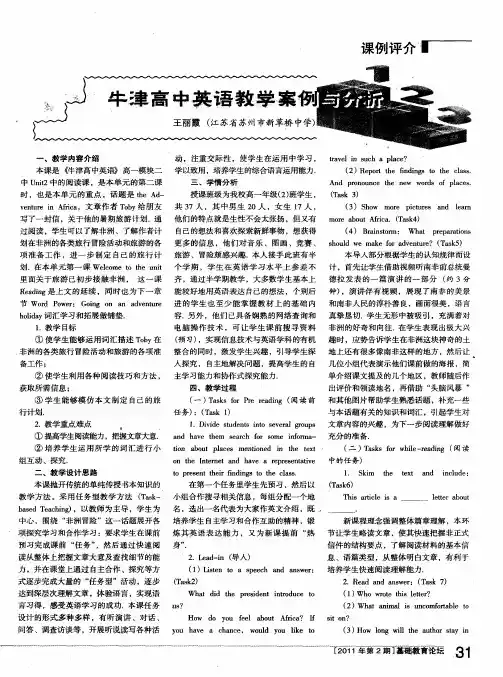
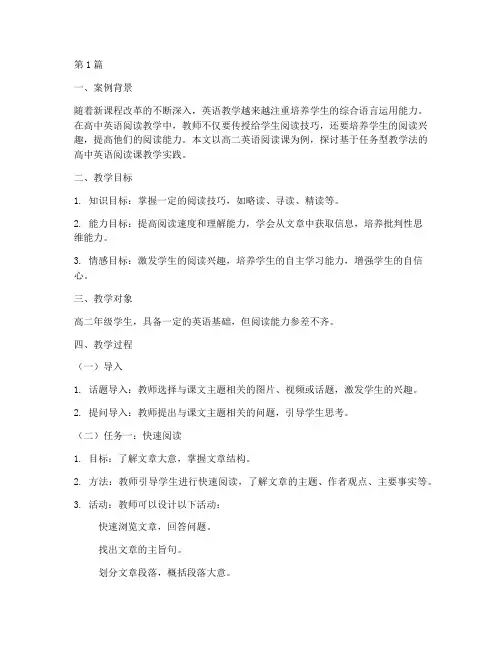
第1篇一、案例背景随着新课程改革的不断深入,英语教学越来越注重培养学生的综合语言运用能力。
在高中英语阅读教学中,教师不仅要传授给学生阅读技巧,还要培养学生的阅读兴趣,提高他们的阅读能力。
本文以高二英语阅读课为例,探讨基于任务型教学法的高中英语阅读课教学实践。
二、教学目标1. 知识目标:掌握一定的阅读技巧,如略读、寻读、精读等。
2. 能力目标:提高阅读速度和理解能力,学会从文章中获取信息,培养批判性思维能力。
3. 情感目标:激发学生的阅读兴趣,培养学生的自主学习能力,增强学生的自信心。
三、教学对象高二年级学生,具备一定的英语基础,但阅读能力参差不齐。
四、教学过程(一)导入1. 话题导入:教师选择与课文主题相关的图片、视频或话题,激发学生的兴趣。
2. 提问导入:教师提出与课文主题相关的问题,引导学生思考。
(二)任务一:快速阅读1. 目标:了解文章大意,掌握文章结构。
2. 方法:教师引导学生进行快速阅读,了解文章的主题、作者观点、主要事实等。
3. 活动:教师可以设计以下活动:快速浏览文章,回答问题。
找出文章的主旨句。
划分文章段落,概括段落大意。
(三)任务二:精读1. 目标:深入理解文章内容,掌握文章细节。
2. 方法:教师引导学生进行精读,分析文章的语言特点、写作手法等。
3. 活动:词语理解:找出文章中的生词,查找词典或利用上下文推断词义。
句子分析:分析句子的结构、语法、修辞手法等。
举例说明:举例说明文章中的观点或事实。
(四)任务三:讨论与表达1. 目标:提高学生的口语表达能力,培养他们的批判性思维能力。
2. 方法:教师引导学生进行小组讨论或全班讨论,表达自己的观点。
3. 活动:小组讨论:围绕文章主题进行讨论,分享自己的观点。
全班讨论:全班同学共同讨论,教师引导并总结。
(五)任务四:拓展与延伸1. 目标:提高学生的综合语言运用能力,拓宽他们的知识面。
2. 方法:教师引导学生进行拓展阅读或实践活动。
3. 活动:拓展阅读:推荐与课文主题相关的书籍或文章,引导学生进行阅读。
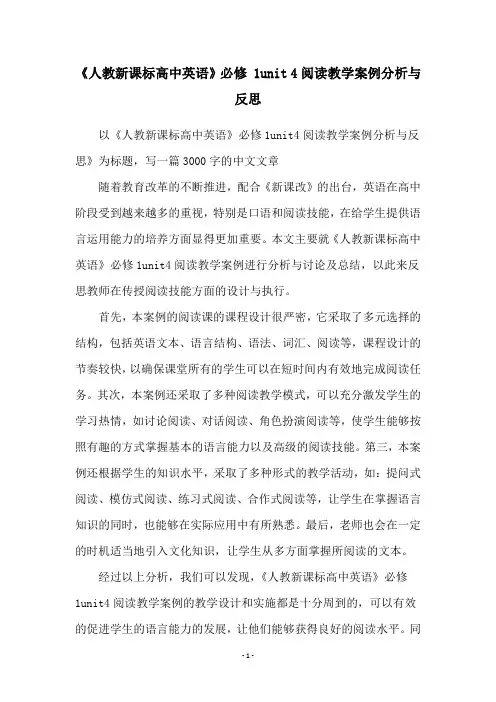
《人教新课标高中英语》必修 1unit 4阅读教学案例分析与反思以《人教新课标高中英语》必修1unit4阅读教学案例分析与反思》为标题,写一篇3000字的中文文章随着教育改革的不断推进,配合《新课改》的出台,英语在高中阶段受到越来越多的重视,特别是口语和阅读技能,在给学生提供语言运用能力的培养方面显得更加重要。
本文主要就《人教新课标高中英语》必修1unit4阅读教学案例进行分析与讨论及总结,以此来反思教师在传授阅读技能方面的设计与执行。
首先,本案例的阅读课的课程设计很严密,它采取了多元选择的结构,包括英语文本、语言结构、语法、词汇、阅读等,课程设计的节奏较快,以确保课堂所有的学生可以在短时间内有效地完成阅读任务。
其次,本案例还采取了多种阅读教学模式,可以充分激发学生的学习热情,如讨论阅读、对话阅读、角色扮演阅读等,使学生能够按照有趣的方式掌握基本的语言能力以及高级的阅读技能。
第三,本案例还根据学生的知识水平,采取了多种形式的教学活动,如:提问式阅读、模仿式阅读、练习式阅读、合作式阅读等,让学生在掌握语言知识的同时,也能够在实际应用中有所熟悉。
最后,老师也会在一定的时机适当地引入文化知识,让学生从多方面掌握所阅读的文本。
经过以上分析,我们可以发现,《人教新课标高中英语》必修1unit4阅读教学案例的教学设计和实施都是十分周到的,可以有效的促进学生的语言能力的发展,让他们能够获得良好的阅读水平。
同时,我们也可以从中总结出一些宝贵的经验,在未来的英语阅读教学中发挥重要作用。
首先,老师应该关注课堂活动的设计,配合课程内容,制定适合学生学习的目标;其次,要运用多种教学模式和教学活动,及时调整教学策略,使课堂活动更加有趣;最后,应该注意把握学生的知识水平,把文化知识和语言技能结合在一起,使学生在阅读的时候能够更好的理解文章的含义。
通过以上的分析与反思,可以看出,《人教新课标高中英语》必修1unit4阅读教学案例采用的教学方式和实施策略都十分成功,不仅可以加强学生对英语阅读技能的训练,更加重要的是,它可以让学生从多方面更加深刻地了解文章的含义,从而使他们的英语能力得到很大的提升。
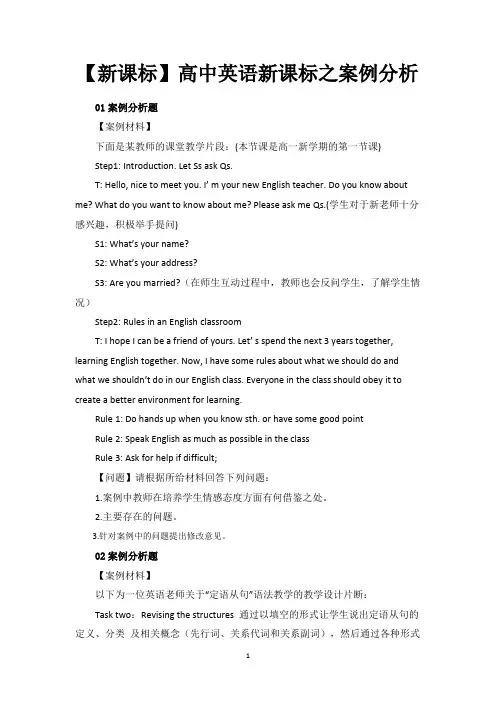
【新课标】高中英语新课标之案例分析01案例分析题【案例材料】下面是某教师的课堂教学片段:(本节课是高一新学期的第一节课)Step1: Introduction. Let Ss ask Qs.T: Hello, nice to meet you. I’ m your new English teacher. Do you know about me? What do you want to know about me? Please ask me Qs.(学生对于新老师十分感兴趣,积极举手提问)S1: What’s your name?S2: What’s your address?S3: Are you married?(在师生互动过程中,教师也会反问学生,了解学生情况)Step2: Rules in an English classroomT: I hope I can be a friend of yours. Let’ s spend the next 3 years together, learning English together. Now, I have some rules about what we should do and what we shouldn’t do in our English class. Everyone in the class should obey it to create a better environment for learning.Rule 1: Do hands up when you know sth. or have some good pointRule 2: Speak English as much as possible in the classRule 3: Ask for help if difficult;【问题】请根据所给材料回答下列问题:1.案例中教师在培养学生情感态度方面有何借鉴之处。
高中英语教学案例及其分析案例一: 提高学生听力能力案例描述在某高中英语教学中,学生的听力成绩相对较低,教师决定采取以下策略来提高学生的听力能力:1. 引入真实语境:通过给学生播放真实的英语对话录音材料,让学生从中感受到语言环境的真实性和多样性。
2. 课堂互动:教师在课堂上组织学生进行听力活动,包括听力对话、听力填空、听力选择等,以增加学生的听力训练机会。
3. 听力技巧训练:教师向学生介绍一些有效的听力技巧和策略,如细听、预测答案、注意关键词等,帮助学生提高听力能力和应对考试。
案例分析通过采取以上策略,学生的英语听力能力得到了明显提高。
学生们更加主动参与听力活动,积极运用学到的听力技巧,提高了听力表现和考试分数。
在这个案例中,教师注重真实语境和互动的教学方法,使学生能够在语言环境中感受到英语的真实性,从而提高听力能力。
此外,教师的技巧训练也帮助学生掌握了一些解题技巧,提高了应试能力。
案例二: 提升学生口语表达能力案例描述某高中英语教学中,学生的口语表达能力较差,教师决定采取以下策略来提升学生的口语能力:1. 组织口语练:教师组织学生进行口语练,包括角色扮演、小组讨论等活动,以提高学生的口语表达能力和流利度。
2. 激发学生兴趣:教师引导学生选择与自己兴趣相关的口语话题,并鼓励学生进行自由表达和互动交流,增强学生对口语的研究动力。
3. 提供反馈和指导:教师及时给予学生口语表达的反馈和指导,帮助学生发现问题并改进口语表达,同时鼓励学生积极尝试和进步。
案例分析通过以上策略的实施,学生的口语表达能力得到了明显提升。
学生们在口语练中更加自信和流利,能够积极参与讨论和交流,表达自己的观点和想法。
在这个案例中,教师重视口语练和兴趣驱动的教学方法,通过提供反馈和指导,帮助学生改进口语表达。
此外,教师的激发学生兴趣也起到了积极的作用,增强了学生对口语研究的主动性和积极性。
结论通过以上两个案例的分析,我们可以得出以下结论:1. 在教学中引入真实语境,可以帮助学生感受到语言环境的真实性,提高听力能力。
高中英语教学案例分析主题:高中英语语法教学要求:选择一种常见的英语语法现象,列出该现象在高中英语教学中需要注意的问题,提供一个可行的教学案例,并分析教学效果和存在的问题,提出改进方案。
一、现象简述:被动语态的应用及误用在英语中,被动语态的用法十分广泛,它不仅可以用于现在时、过去时及将来时中,而且在完成时,过去完成时和将来完成时中也有运用。
被动语态能够清晰地表达被动句子中的动作及其承受者,对英语学习者的语言表达有很大的帮助。
然而在实际教学中,学生往往会出现一些误用,例如错误使用被动语态、改变主动语态等。
二、教学案例1. 教学目标:(1)了解被动语态及其用法。
(2)掌握被动语态的基本构成及应用方法。
(3)能正确地运用被动语态进行语言表达。
2. 教学步骤:(1)导入介绍实际生活中使用被动语态的情况,例如新闻报道、广告宣传等等,引出被动语态的定义及其用法。
(2)讲解通过教师的讲解及例句的演示,让学生掌握被动语态的构成及应用方法。
(3)练习(a)选择性的填空练习,将给出的动词填入已构建好的被动语态中。
例如:The room _____ (clean) every day.答案:is cleaned.(b)根据所给提示,给出正确的被动语态句子。
例如:They will send the letter to her tomorrow.(改为被动语态)答案:The letter will be sent to her tomorrow.(4)拓展引导学生运用被动语态进行写作,例如作文、翻译练习等。
3. 教学效果分析通过教学案例的实施,学生能够掌握被动语态的使用方法,但是存在一些不足之处。
例如,部分学生在运用被动语态时,容易忽略被动语态中的主语,或者使用错误的被动语态形式。
这些问题反映出学生对被动语态的掌握还不够深入,需要进一步的巩固和练习。
4. 改进方案在巩固教学的基础上,可以通过以下方式进一步提高学生的被动语态运用能力:(1)强化语法变形过程中的注意力,确保正确作答。
高中英语优秀教学设计3篇(人教版高中英语教学设计优秀案例)下面是收集的高中英语优秀教学设计3篇(人教版高中英语教学设计优秀案例),以供借鉴。
高中英语优秀教学设计1一、教材分析:本课是结合人教版高中英语教材选修5中有关过去分词的语法内容,进行过去分词的学习,教学中将语法知识的传授和语言基本技能的学习结合到一起,注重复习语法与语言的运用。
采用任务型教学法和小组合作探究学习法,从而扩大课堂的语言输入量及学生的语言输出量。
二、学情分析:在高一英语学习基础上,学生已经掌握基本的语言结构和一定程度的听说读写能力。
在复习的过程中,结合学生原有的知识掌握水平,巩固基础强化正确使用语法知识,提高学生运用语言的深度和难度.但大部分学生的基础知识仍然较为薄弱,运用英语进行交际活动的能力较差,主动学习的动力不够,然而他们学习比较认真,渴求知欲旺盛,思维比较活跃。
部分学生的基础较好,能主动配合老师。
只有设置使他们感兴趣的活动,因材施教,才能让他们投入到课堂活动中来。
三、教学目标:1.知识目标:引导学生掌握过去分词在真实的生活语境中的使用。
培养学生通读,分析,理解,综合的能力,教会学生体察语境,结合上下文,符和逻辑推理和合理的想象,结合语法和题干中的语境解决问题。
在运用语言过程中培养学生的观察力、分析力、想象力和自学能力,提高思维能力和运用英语的综合能力。
2.能力目标:利用多媒体手段营造积极和谐教学氛围,使学生进入情景之中,充分调动学生的思维活动和情感体验,规范学生运用英语知识准确表达的能力,同时,发展学生综合语言运用的能力,分析问题和解决问题的能力,培养学生自主学习。
3.德育目标:用含过去分词的句子结构表达思想感情。
四、教学重点:1.过去分词的用法.2. 过去分词的运用五、教学难点:1.结合语法知识,以课堂教学为依托,全面训练学生的听、说、读、写能力,加强和提高运用英语的综合能力。
2. 过去分词在真实的生活语境中的使用。
高中英语教学案例设计分析总结高中英语是高考的重要组成部分,对于高中生的学习,作为一名英语老师应该做出怎样的教学教案呢?下面是有店铺为你整理的高中英语教学案例设计篇,希望能够帮助到你!高中英语教学案例设计篇一一、学生分析教学对象为高中一年级学生,他们的认知能力比初中阶段有了进一步的发展,渐渐形成用英语获取信息、处理信息、分析问题和解决问题的能力,因此需要特别注重提高学生用英语进行思维和表达的能力。
他们学习英语方法由死记硬背转型向理解型并应用到交际上,他们有自己的学习技能和策略,学会把语言学习与现实生活和兴趣联系起来。
通过任务型课堂活动和学习,学生的学习自主性得到加强,不再认为英语的课堂学习很枯燥,主动参与到活动中去,成为课堂的主体,同时也加强了与他人交流合作的能力。
二、教材分析这一课是本单元第一个课时。
由于这课出现的生词比较多,在课前教他们读了一下。
在备这一课时,发现它的有关宇宙的知识很专业,起初比较担心,但是得知高一的学生地理课上已经学习了相应的部分知识,有了一定的知识储备,这样在处理的时候就注意到详略的问题,我觉得在今后也必须对学生的知识结构有所把握,这样才会更好地抓住要点和难点。
三、教学目标本课为阅读课型,主要介绍有关太空知识和人类起源。
通过阅读使学生了解宇宙的形成,和人类的形成。
课文内容用不同的形式来让学生自己归纳,提高阅读技能。
由于这课讲述有点抽象,需要足够的图片,方便理解并形成感性认识。
本课目的要使学生了解宇宙形成和人类起源,培养环境保护意识。
教学内容大致分为以下几个方面:1.看图片引入宇宙形成这一话题。
2.从网上下载一些宇宙空间图并展示给学生看,弄清楚星际空间的划分,给学生以感官上的刺激,而且有利于帮助学生对文章的理解。
(一些生词用板书)3.学生阅读课文后完成精读练习。
4.两人围绕人类起源进行讨论。
5.语言学习:难句解释。
6.小结文章,一是找关键线索,二是写作手法。
7.小组讨论,包括复述课文,加深对文章的理解,以及学生总结自己通过本课学习学到了什么(达到教学目标--形成保护环境意识)。
高中英语教学案例描述
案例描述:
本案例是关于高中英语教学的,主要涉及到词汇教学和阅读理解教学。
一、词汇教学
在一次高一英语课上,教师正在教授一个新单元的词汇。
教师首先通过图片和实物引导学生猜测新词的意思,然后展示单词卡片,让学生读出单词并尝试解释其含义。
接着,教师设计了一些活动,如单词接龙、填空游戏等,让学生在游戏中记忆和巩固新词。
最后,教师布置了一些课后作业,要求学生用新词造句,并在下节课上进行分享。
二、阅读理解教学
在一次高二英语课上,教师正在教授一篇关于环保的阅读理解文章。
教师首先带领学生阅读全文,然后提出一些问题,让学生思考文章的主题和主要内容。
接着,教师让学生分组讨论文章中的细节问题,如作者的观点、文章的结构等。
然后,教师让学生自己阅读文章,并完成一些阅读理解题目。
最后,教师让学生分享他们的解题思路和方法,并对全班的答案进行讲解和讨论。
通过这两个案例,我们可以看到,高中英语教学需要注重学生的参与和实践,通过各种活动和任务,帮助学生掌握和运用英语知识。
同时,教师也需要关注学生的学习过程和结果,及时给予反馈和指导,以提高教学效果。
高中英语新课标案例解读
一、案例背景
本案例以高中英语新课标为背景,探讨如何通过案例教学提高学生的英语综合能力。
在新课标下,英语教学更加注重学生的实际应用能力,而不仅仅是应试能力。
因此,本案例将结合实际情境,通过案例分析、讨论和实践,帮助学生提高英语应用能力。
二、案例内容
本案例的主题为“旅游”,主要涉及旅游景点的介绍、旅游计划的制定、旅游过程中
的沟通等实际情境。
通过这个主题,学生将学习到如何在不同情境下使用英语进行交流,提高他们的口语表达、听力理解和写作能力。
三、案例实施过程
1.导入阶段:教师通过展示一些旅游景点图片,引起学生的兴趣,并引导学
生思考自己在旅游中可能会遇到的问题。
2.案例分析阶段:教师介绍一个具体的旅游案例,引导学生分析其中涉及的
英语表达方式和句型,让学生了解旅游中常用的词汇和表达方式。
3.模拟实践阶段:学生分组模拟不同的旅游情境,进行角色扮演,练习使用
英语进行沟通。
教师对学生的表现进行点评和指导。
4.总结反思阶段:教师引导学生总结本次案例学习的收获,反思自己在英语
表达方面存在的问题,并提出改进意见。
四、案例效果
通过本案例的学习,学生能够更加深入地了解英语在实际生活中的应用,提高他们的英语交际能力。
同时,学生在案例分析、讨论和实践的过程中,也能够培养他们的批判性思维和团队协作能力。
高中英语教学案例--人教版第九册Unit one Breaking the recordThe Way is always ahead of us Part 2赵丰高三英语课堂教学设计案例(高三选修九第一单元Breaking the record 第二课时阅读课)引言在英语教学中落实新课程标准,就是贯彻执行国家教育部关于课程改革的决定。
新课程标准的三维教学观,具体到英语学科就是要整合发展学生语言技能、语言知识、情感态度、学习策略和文化意识五个方面的素养,培养学生综合运用语言的能力探究学习、合作学习、任务型学习是在新课程标准下实施素质教育的关键环节,所以在我的教学设计里,时时体现着这几种原则。
教学设计理念1、运用任务型语言教学模式,训练培养学生对语言的综合运用,实现目标,感受成功,教学进度整体把握,教学形式不拘一格。
2、课堂以学生为主体,以任务为主线,重视体验参与,教师起到“设计者、研究者、促进者、协调者”的作用。
3、在教学中,突出交际性,注重读写的实用性,要进行情感和策略调整,以形成积极的学习态度,促进语言实际运用能力的提高。
4、课后访谈调查,读写摘记,重视语言运用。
5、正视个体差异,倡导过程激励,以多层次、多角度、多主体的结果与过程并重的评价方式激励进步。
一、学情分析一方面,高中年龄段的学生对周围的事物较为敏感,有自己的观点和看法,他们不满足于教科书上的知识,想获得更多的信息。
在英语学习上,他们不只是想把英语作为一门死记硬背的课程来学,更希望能学到知识性和趣味性兼有的内容,从英语学习中获得更多的知识和能力。
另一方面学生对体育比较感兴趣,对吉尼斯纪录有一定的了解因此,应结合学生的实际情况,因材施教,激发学生兴趣,让学生主动学习,学有所获。
二、教学内容分析(一)知识背景及新课程、新教材本单元以世界纪录为中心话题,只要内容涉及以阿里西塔福尔曼为代表的几个世界吉尼斯纪录的保持者及其运动经历,重点讨论了创造吉尼斯纪录所必备的身体素质心理素质创新意思以及挑战自我的决心和毅力语言和技能都是围绕这一中心展开的。
本课是是本单元第二课——“阅读课”,于是本单元的重点。
文章的主题是“路永在前方”其内容介绍了世界吉尼斯的保持者阿西里塔福尔曼,他不是职业运动员,但其运动成就让许多运动员望尘莫及,本课通过阿里西塔福尔曼的成长经历以及获得这些成就的精神动力激励学生认识自我的潜力找到精神动力的源泉,实现梦想。
(二)教学重点难点(1)重点:1.了解记叙文的文体特点并以此指导阅读;训练skimming, scanning, careful reading等阅读微技能;3.对文章深层次的理解及细节的欣赏,认识及分析主人公的人物特征及人物性格。
(2)难点:1。
阅读技能的训练;2.对记叙文的鉴赏能力及人物评价。
(确立依据:阅读在整个英语教育体系和高考中都占有重要比例,阅读能力的提高不是一朝一夕事。
再高明的老师也不可能把自己的阅读能力传授给学生。
学生阅读能力的提高只能在老师的指导下通过实践训练获得。
复述课文是检查学生对课文的理解程度,同时又是提高学生口语能力的重要方法)三、三维教学目标(一)知识技能①通过本课的学习使学生能够在理解的基础上复述课文②在阅读中体会并初步掌握生词、词组句型的用法③体会作者在写本文时是如何进行内容安排的(二)情感态度①了解吉尼斯纪录的相关知识、以及勇于挑战并打破纪录的杰出人物应具备的品质②鼓励学生打破“我不行”的心理暗示让意念统领身体走出一条完美的道路(三)学习策略(能力目标)1.认知策略:①通过词族和词缀的学习让学生掌握一种记忆单词的方法,②通过三读法让学生掌握速读、跳读、精读的要领2.调控策略:通过阅读让学生了解到阅读过程中与很多阅读障碍,不可求全责备,调整心态和注意力,通过读懂细节,推断隐含内容,要掌握大意。
获取所需信息。
依据:在新课程理念要求老师传授给学生阅读方法,读阅读进行整体教学,而不在局限于单词句型的传统教授。
在学生现实阅读当中很多学生过分地方注意力放在生词上面,而不注意阅读方法的培养,反映在考试中为遇到一片生词较多的语篇就丧失了阅读的信心。
3.交际策略:通过谈论体育项目、埃西里塔福尔曼等真实交际活动提高用英语交际的能力。
4.资源策略:让学生了解网络图书馆和书籍资料一样是学习的重要途径。
(四)文化意识:了解吉尼斯的相关知识,加深对吉尼斯纪录的了解(教学目标的确立依据:本课是阅读课,课文是对话,阅读是英语教学的重点,也算是难点,同时根据英语标对学生能力的要求,本课教学以阅读教学为主,同时兼顾听说能力的培养,另外根据本单元的内容和特点把德育教育渗透到教学当中去)四、教法分析教学方法:问答法(question and answer) 讨论法discussion 辩论法(debate)taks-based method(任务教学法)教具教学手段:①Multi-media computer; OHP(overhead projector); tape recorder; PowerPoint②多媒体辅助教学(依据:根据本课特点以教材为本,传统教学手段和现代多媒体教学手段相结合,恰当合理呈现本课内容。
)五、学法指导阅读是一种积极主动地吸收、思考、理解、接受信息和反馈信息的过程,也是一种复杂的智力活动。
培养学生的阅读理解能力可分三个层次:表层理解、深层理解和评价性理解。
表层理解是培养学生对文章表面信息的把握;深层理解是引导学生通过联想、推理、归纳等思维活动对文章主题或某一章节进行进一步的理解;而评价性理解建立在从整体角度对课文深层理解的基础上,旨在引导学生联系社会实际或自身生活,对某一相关话题进行讨论,使学生进行发散性、创造性思维。
通过一学期的阅读教学,学生已初步建立了阅读的基本技能—Skimming(略读)和Scanning(查读),教师引导学生结合语境,采用推测、查阅或询问等方法进行学习。
六、具体教学步骤(Teaching procedures:)教学过程流程图Leading-in(导入) 激趣Pre-reading(读前) 任务一铺垫任务二表层理解While reading(读中) 任务三表层理解任务四深层理解Post reading (读后) 任务五评价性理解Summary &homework(总结与作业) 任务六阅读的延伸综合运用语言的能力文化意识策略Leading-in (discussion)To show Ss pictures about some famous athletes to let them know something in common about these people--the key of success.Some words may be used in this activity :Sports champion athlete winning breaking records challenge exciting confidence physical ability speed strengthSomething in common:concentration confidence good physical abilities speed strength flexibility athletic skills strong will interest hard training目的及依据:本环节通过看图讨论激发学生的学习兴趣激活已有的背景知识,使学生能运用已有的知识和经验思考本单元的中心话题。
能起到温故而知新的作用。
Pre-readingTask oneto show students some pictures which occur in the text,First, lets them to know the name of the activity and the way to do it,Second, let the students experience one or more of this, such as somersaulting doing jumping jacks,Third, thinking and discussing①Would you consider each activity to be serious sports?②Which activity would you like to try? Would you need to be fit to do any of them?③Do you think you could do any of them for any length of time?(Indication:Different activity requires different physical fitness psychological personification such as coordination strength balance? concentration strong will devotion)Now class we will read a story about a man called Ashrita Furman who has broken Guinness records.(过度)(读前部分设计依据及目的:本部分根据学生的认知规律而设计,首先让学生借助图片了解运动的名称及运动方式,其次,让学生体验其中一项或几项活动,体验后让学生思考问题这种方式有浅入深由感性认识到理性思考了解文章当中提到的运动项目降低阅读难度,为下一步阅读理解做好充分的准备)While readingTask two Listening (scanning)(close your book 此处把快速阅读与听力整合在一起正大课堂容量加快课堂节奏) (提高学生的听力水平培养快速获取所需信息的能力)Task twoListen to the tape, after listening tick the topics that the author does not cover①physical skills needed for events ②number of records broken ③his family life ④kind of records broken ⑤why he became a sportsman ⑥countries he likes best⑦place and date of birth ⑧his occupation ⑨his education ⑩his first Guinness record(目的及依据,新课程理念要求让学生对语篇整体学习,为此首先让学生快速把握文章结构要点让学生从整体明白文)Task threeSkim the text and answer the questions①Who is Ashrita Furman?②When and why he entered the Guinness book of world records?③When did Ashrita become a student Chinmoy?Explain some new words and sentences in the text (解决阅读障碍)Task fourCareful reading first look through the questions①Where do you think Ashrita lives?②How do you know③Has he broken records in all seven continents?④When did he first come across the Guiness book of the world records⑤What are some of his pgysical difficulties?A walking with a bottle of milk on his headB standing on top of a Swiss ballC somersaultingD doing gymnastically correct lunges⑥what happens in an event that prevent Ashrita from giving up?Post readingTask fiveDiscussion on Ashrita’s motivation①Why did Ashrita challenge the Guinness world records instead of taking part in the Olympic games?②Why does he keep on trying to challenge different Guinness records?③Why didn’t he take part in a conventional sports instead of un conventional and funny one?④Why did Ashrita took part in active sports after learned quiet mediation?Task sixdiscussion on Ashrita’s belief.work in group four or five each group may be for it or against it, choose one, and discuss with your group, (divide the class into two parts for-part and against part, then have a class report)Task sevenSummary and homeworkTask oneWrite an article about the imagination about the outlook of AshritaTask twowork in group to find more information about Ashria through internet as well as books about after class each group should try brief paper about ahsrita.七、教学时间分配教育心理学指出新知识的学习需要一个接受的过程。